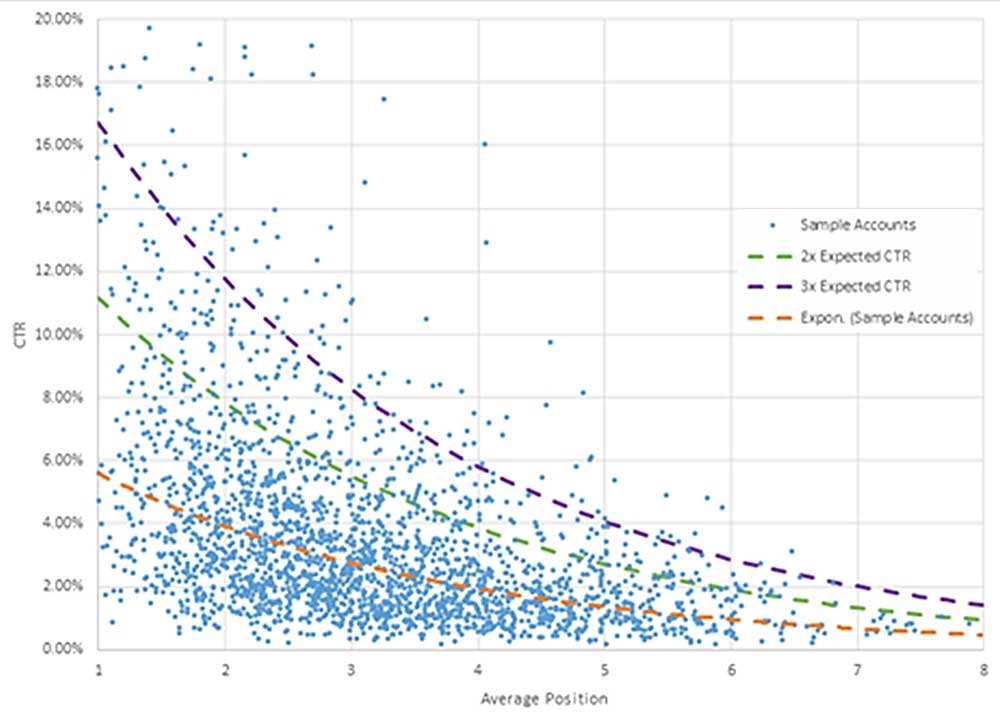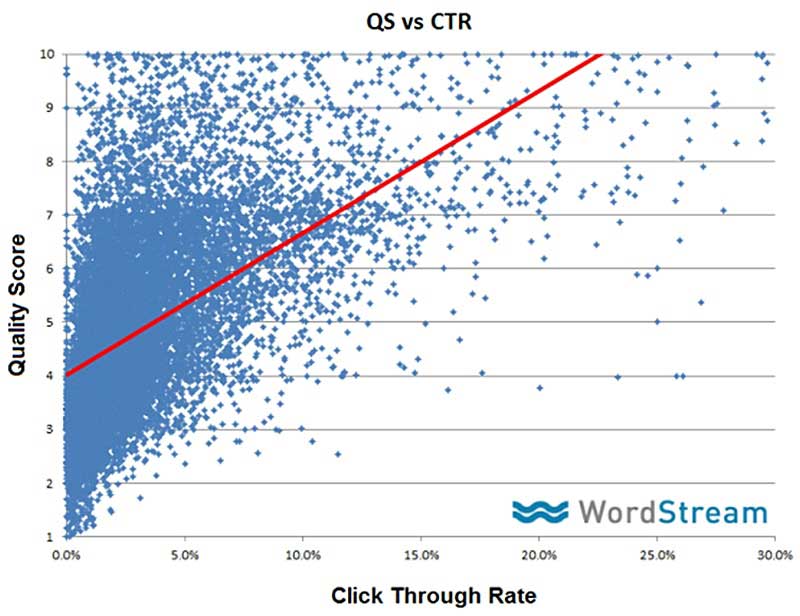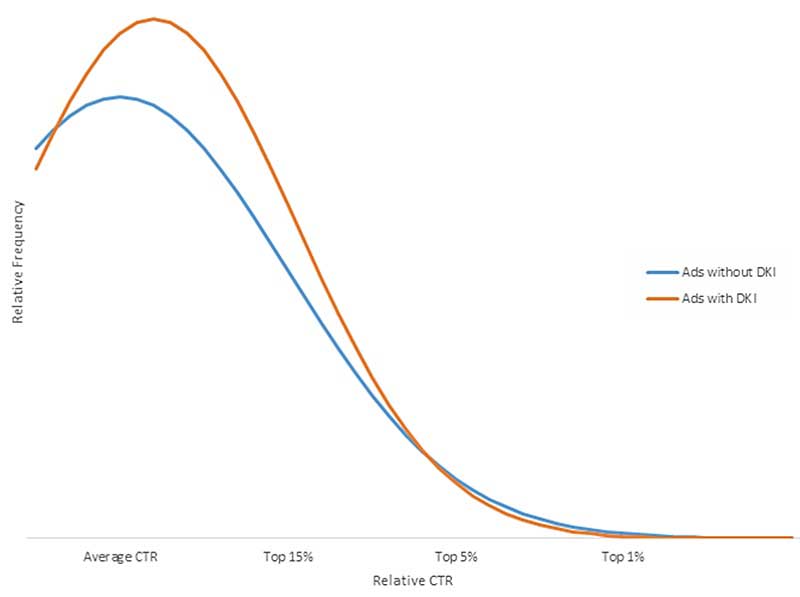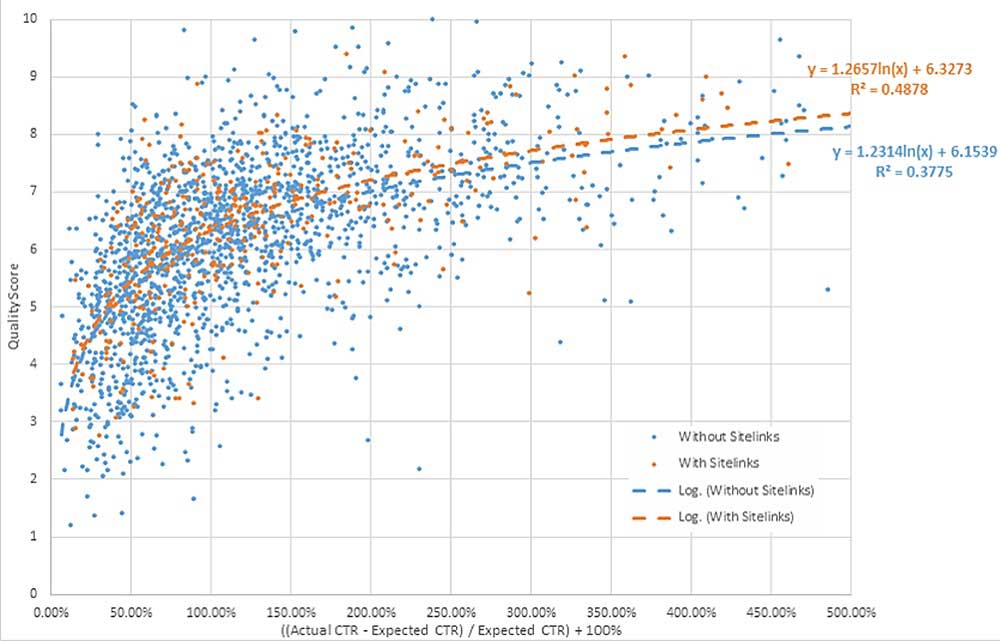In this article, I'm going to discuss four common mistakes marketers make that drag their AdWords clickthrough rate (CTR) down, and I'll show you how you can write ads that get 2-3 times the average CTR.
We've analyzed millions of dollars in ad spend by advertisers of all sizes across all industries, and we've found that they are making these four mistakes.
That's good news for you: Once you learn to identify and remedy these missteps, you will have a definite edge on your competitors.
The following chart illustrates the relationship between your ad's average position and expected average CTR:
Each blue dot in the figure represents an advertiser account. The orange curve is the average advertiser account CTR (note that this is not for individual ads but for entire AdWords accounts) by ad position. The green curve shows accounts performing at twice the average CTR, and the purple curve shows those that have three times the average CTR.
As for those blue dots way up at the top... those are the top performers: accounts with average CTRs that are far outperforming their competitors and exceeding the average by up to six times.
First, let's discuss why you should strive for much better CTRs.
Why CTR Matters
Good click-through rates are essential for AdWords success, for more than the obvious reasons (you can't convert if you don't first get the click).
CTR measures the impressions that result from clicks on your ad, but CTR also has a direct and substantial impact on your Quality Scores and the amount you pay for each click.
A higher CTR tells Google your ad is relevant to its audience and is therefore a good "answer" to the user's query. That's important, because Google wants to show the most relevant ads in order to provide a better user experience (and, of course, generate more revenue).
Higher CTRs therefore lead to higher Quality Scores, which result in lower costs per click, better ad placement, and more impressions.
If you're not optimizing your CTRs, you're overpaying for clicks and missing out on opportunities to appear in front of more qualified audiences.
AdWords Mistakes Marketers Make
Here are four common ways marketers sabotage their own CTRs.
AdWords Mistake No. 1: Failure to Focus on These Three Keyword Types
Keyword research, selection, and testing are challenging; Google processes close to 6 billion queries every day , and 15% of those are new queries it has never registered before. Crazy, right? Finding just the right keywords takes a solid strategy and constant testing.
However, we know that there are specific types of keywords that generally indicate greater intent and therefore perform better for PPC marketers.
1. High Commercial Intent Keywords
Avoid informational keyword terms that fail to show commercial intent. For example, "what is internet marketing?" indicates that the user is searching for Wikipedia-type, general information. The user has given no indication that he's in the market to buy. However, "what is the best internet marketing software?" tells us this searcher is likely comparing software options, probably in preparation to purchase. "Buy internet marketing software," of course, shows even greater intent.
The purpose of your campaign is to make a sale or otherwise convert a prospect, so avoid wasting spend on people who are looking for general information.
2. Branded Keywords
Branded keywords are another keyword type that can generate higher than average CTRs. Focus on your own, but also on those of your competitors. For example, a person searching for "Ford Focus" may not be 100% set on purchasing a Ford Focus; maybe they're in the market for any compact car. Competitors therefore have an opportunity to bid on Ford's branded term to appear in search results and potentially generate interest in their own compact offering.
3. Local Keywords
Local and mobile are closely related. We know, for example, that 81% of smartphone users rely on their mobile device for local shopping information. Homing in on local keywords can help you get in front of consumers who are on the go, actively searching for information and displaying high intent to purchase. They may be looking for a type of business (or even a specific business), or a product or service, in a geographic area, and these people are far along on their path to purchase.
AdWords Mistake No. 2: Overly Relying on Dynamic Keyword Insertion
Dynamic Keyword Insertion is a helpful PPC feature that allows Google, Yahoo, or another ad server to customize elements of your ad text to better fit a query. A single generic ad can be used to target multiple keyword terms, as Google simply changes out the term you've indicated for the one the searcher is using. In this example, I could target "new couches," "leather couches," "microfiber couches," or any other variation and Google would insert that term in place of the keyword "couches." (You can learn more about DKI here.)

Pretty handy, right? However, it can be dangerous to rely on DKI too much. It's a useful feature, but it provides a lift in CTR only to a point, as shown in the following chart:
DKI has a tendency to produce above-average CTRs in the top 15-20%, but then drops off. Use it, but don't rely on it alone.
AdWords Mistake No. 3: Not Using Ad Extensions
Ad Extensions are one of the most underused weapons in the AdWords arsenal. Ad extensions are "a feature that displays extra business information with your ad, such as an address, phone number, more webpage links, or a coupon," according to Google.
Ad extensions offer greater ad functionality and can enable you to take up more room on the SERPs, offer additional links to your site, provide contact information or click-to-call functionality, add images, and more. (See The Ultimate Guide to Google AdWords Ad Extensions for more on the many types of extensions offered and which ones might be a good fit for your business goals.)
Accounts using sitelinks in their ads do see an incremental lift in CTRs, as we see in the following chart:
Again, using this feature alone isn't going to shoot you to the top, but neglecting to use ad extensions denies your account that lift from using them properly. You still need fantastic ad copy, which brings us to the fourth and final critical error marketers that drags down their CTRs.
AdWords Mistake No. 4: Boring, Generic Ad Copy
Most ads are boring. Look at these results for "Houston divorce lawyer"; they're all the same, and it's a total snoozefest.

Is there anything about any one of those ads that would make you choose one over the other, besides placement? What a waste, right?
The following ad appeared right at the bottom of the first-page right sidebar; and although the advertiser at least attempted to be different, the ad is still boring.
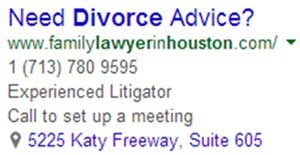
Too bad it's down the page so far that it will hardly get any clicks. This marketer needs to work on CTR and Quality Score to get better placement! I hope you can see that just as good placement can't save a boring ad, nor can creativity save an ad that's so far down the page that no one will see it. You have to get all of your efforts working in tandem for best results.
So how do you create more compelling ads? Here's a good example:
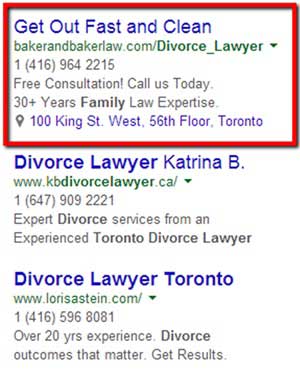
In a sea of ads that all say "Divorce Lawyer," this ad stands out and answers a personal need for the searcher. It addresses the emotion beneath the search query: "I'm sick of this, I just want out."
But how about this one? In this example, the advertiser has identified a potential cause for the query about divorce and is targeting an emotional need for revenge.

That's pretty much guaranteed to get more attention than another boring, generic divorce-lawyer ad.
There's a really simple but effective process you can use to help discover these emotional triggers and understand how your brand can connect with the searcher.
Ad copy has to be unique and emotionally charged to strike a chord with the person doing the search.
Perry Marshall is an incredibly gifted marketer who understands how to truly stand out in a sea of boring PPC ads and appeal to a targeted audience. His Swiss Army Knife brainstorming process helps bring structure and reason to your PPC ad copywriting efforts, resulting in more effective, compelling copy.
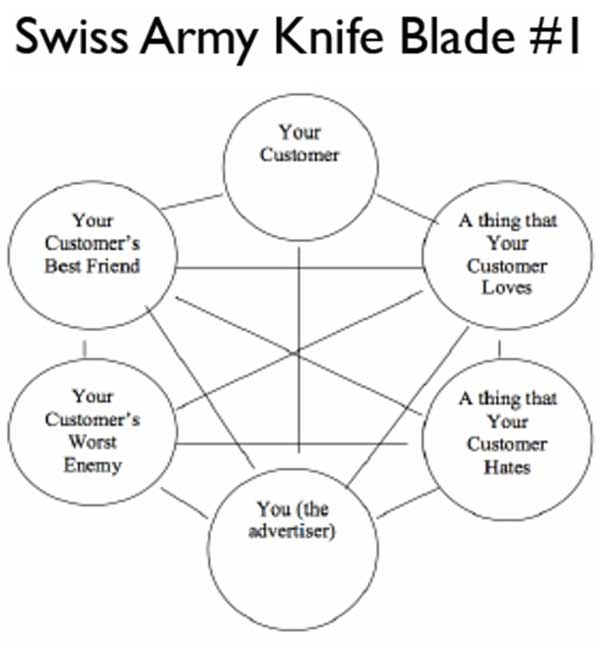
Focus on Optimizing CTRs for More Clicks, Lower CPCs, and Higher Quality Scores
CTRs are just one metric, it's true; yet that one element in your campaign carries incredible weight. It's worth investing the time into optimizing your CTRs in order to boost your QS and lower your costs per click.
Higher CTRs without conversions are useless, though, and they can result in a great deal of wasted spend. The tactics outlined above should be used to increase not only click volume but also relevance. In a future article, I'll offer tips and tricks for increasing your conversion rates well above the industry average.
